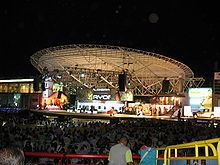Years active every year since 1967 Dates 26 Apr – 30 Apr 2017 | ||
 | ||
Profiles | ||
Vallenato legend festival
The Vallenato Legend Festival (Spanish: Festival de la Leyenda Vallenata) is one of the most important musical festivals in Colombia. The Festival features a vallenato music contests for best interpreter of accordion, caja vallenata and guacharaca, as well as piqueria (battle of lyrics) and best song. It’s celebrated every year in April in the city of Valledupar, Department of Cesar.
Contents
Origins
Its origin dates back to 1968 when the celebrated vallenato composer Rafael Escalona, the then governor of the state of Cesar and former president of the republic of Colombia, Alfonso López Michelsen, and the writer, journalist and former Minister of Culture Consuelo Araújo, came up with the idea of organizing a festival that celebrated vallenato, a musical genre that’s autochthonous to Colombia’s northern atlantic coast and also celebrate a religious festivity of "The Virgin of the Rosario".
Since 1986, the organization of this festival rests in the hands of the Fundación Festival de la Leyenda Vallenata (Vallenato Legend Festival Foundation) a non-profit private entity in charge of the promotion, publicity and defense of vallenato music as one of the immaterial cultural legacies of Colombia.
The Legend: The legend says that during the Spanish colonial period, two amerindian tribes from the Tairona culture; the Tupe and the Chimila, along with other members of other tribes, rebelled against the Spanish colonizers after one indigenous woman named Francisca who worked as a maid for a Spanish family was severely punished by her jealous master, who cut her hair and whipped her publicly. One of her fellow Indian tribesmen also working for the Spaniards, escaped and told his tribe's cacique about this offensive insult. The angry Indians organized an attack, destroying most of the town and killing many people. When trying to destroy the temple, the "Virgin of the Rosario" appeared and with her cape blocked their arrows preventing them from destroying it. The natives, scared, escaped to the Sierra Nevada de Santa Marta, and knowing that the Spaniards would follow them and would be in need of drinking water, they poisoned the "Sicarare lake". This resulted in the death of all the Spaniards involved. The Virgin reappeared and began touching their bodies with her wand and reviving them. The surprised Indians finally surrendered.
The Contests
The most important event during the celebration of this festival is the vallenato musical contest. The winners are chosen by a vallenato experienced jury that evaluate the contestants’ prowess in the four main rhythms which are paseo, son, puya and merengue. There are several categories in which the contestants may participate including: "professional accordion player", "amateur accordion player", "young accordion player", "best new vallenato song", and piquerías (in which each competitor's goal is to 'diss' their opponent through clever lyrics).
Besides the annual winners, there is also a special award given to renowned vallenato composers and performers, a statuette known as La Pilonera Mayor, which is given in recognition of the recipient’s dedication to vallenato music. La Pilonera Mayor is the highest honor given to a vallenato musician in Colombia and only six composers have received it until now. This award is given in honoris memoriam of disappeared Consuelo Araújo.
King of Kings
The Rey de Reyes festival editions occur every 10 years, since 1987 and only previous winners can participate. The first winner was Colacho Mendoza, followed by Gonzalo "Cocha" Molina, the third King of Kings Hugo Carlos Granados won on May 1, 2007.
Winners
La Pilonera Mayor Award: Emiliano Zuleta Baquero, Rafael Escalona, Leandro Díaz, Calixto Ochoa, Adolfo Pacheco and Tobías Enrique Pumarejo.
Dances and other events
Piloneras Parade: This traditional dance was recovered from extinction in 1994 thanks to the Vallenato Legend Festival Foundation effort, and was added to the festival's programming as the opening show. This dance is traditional of the magdalena river reveres. Traditionally Dancers paraded on the streets using a giant wooden mortar and pestle, (usually used to squash corn and produce corn flour), the men and women danced around the 'corn smashing' in a courteous and flirting way, dancing in front of friend's houses to receive liquor in exchange. But the festival kept the dance and turn it into a competition among groups of Piloneros and whoever exposes the best show becomes the winner. There are three categories; Infants, youth and adults.
Other events:
